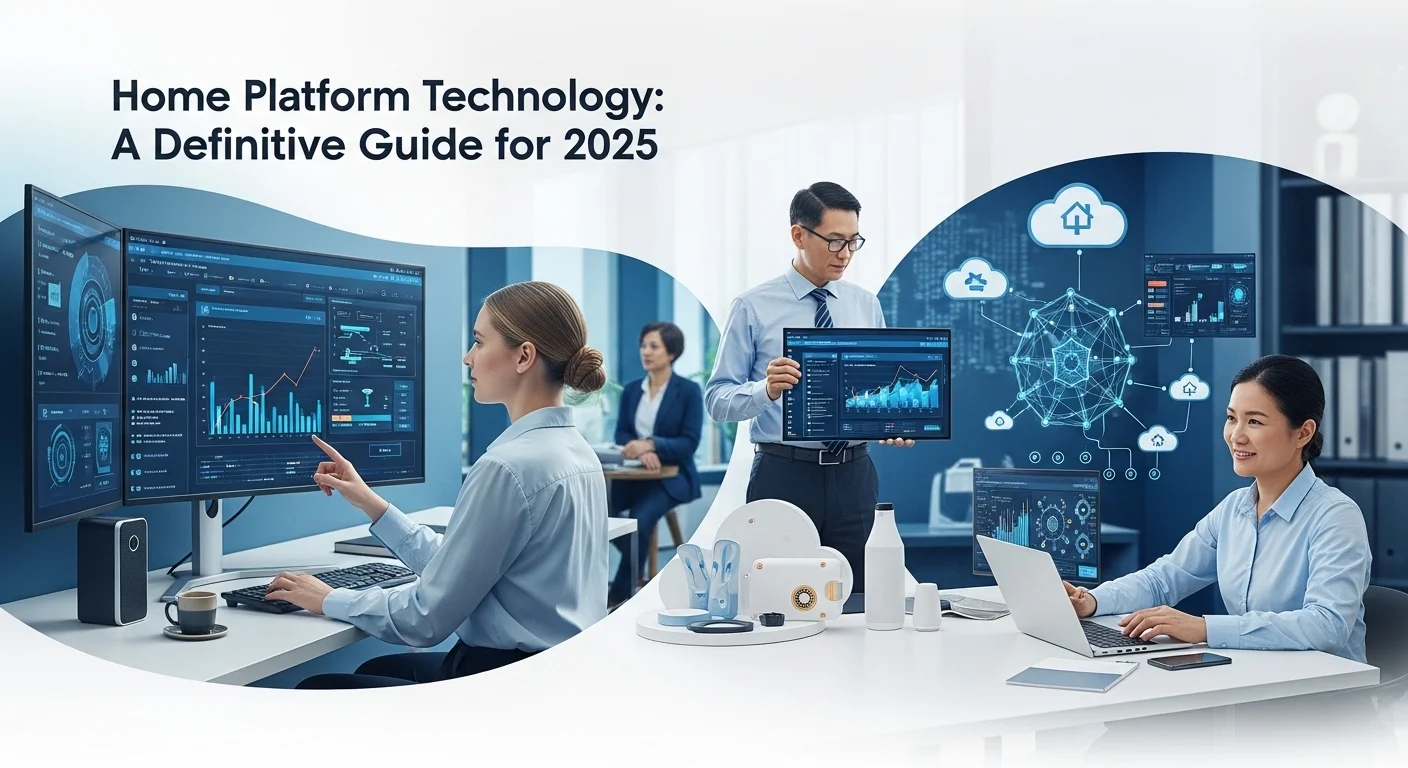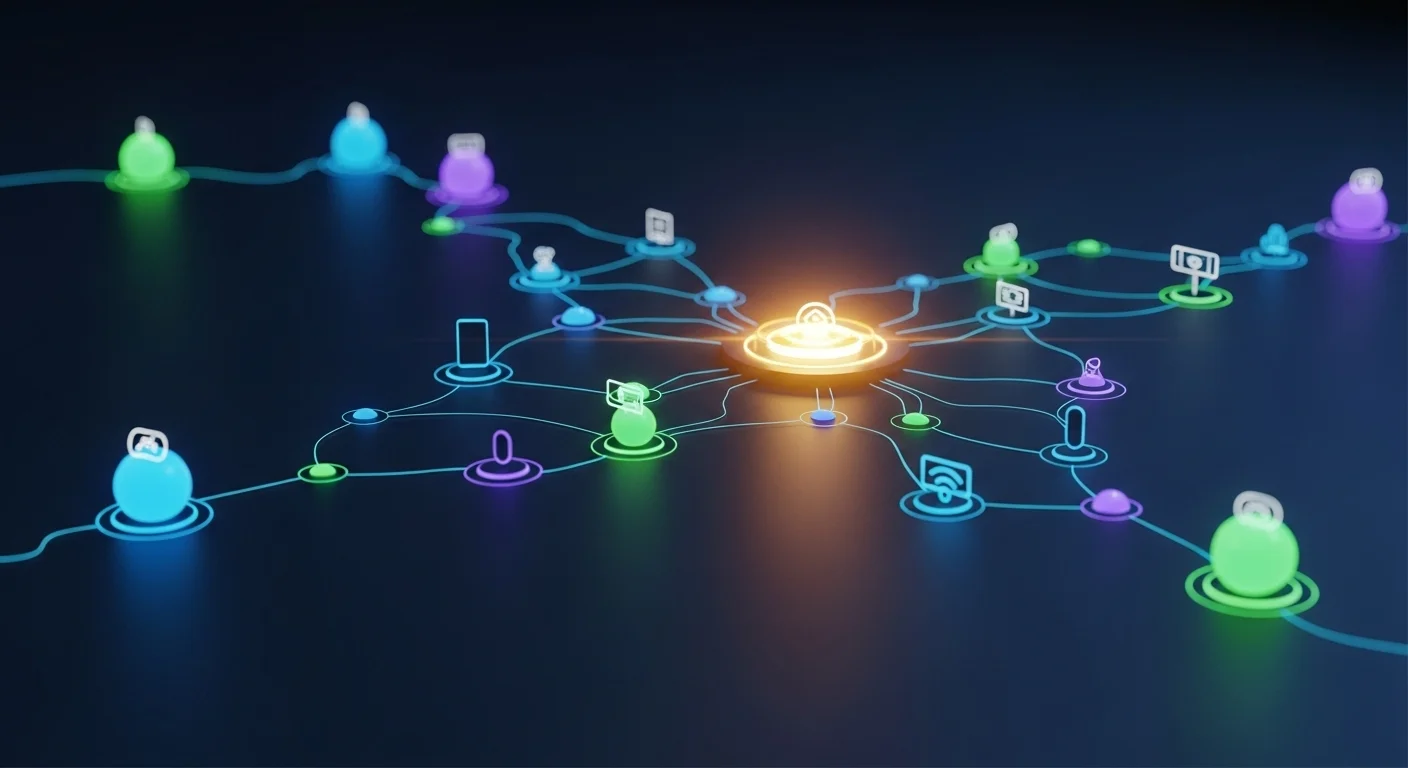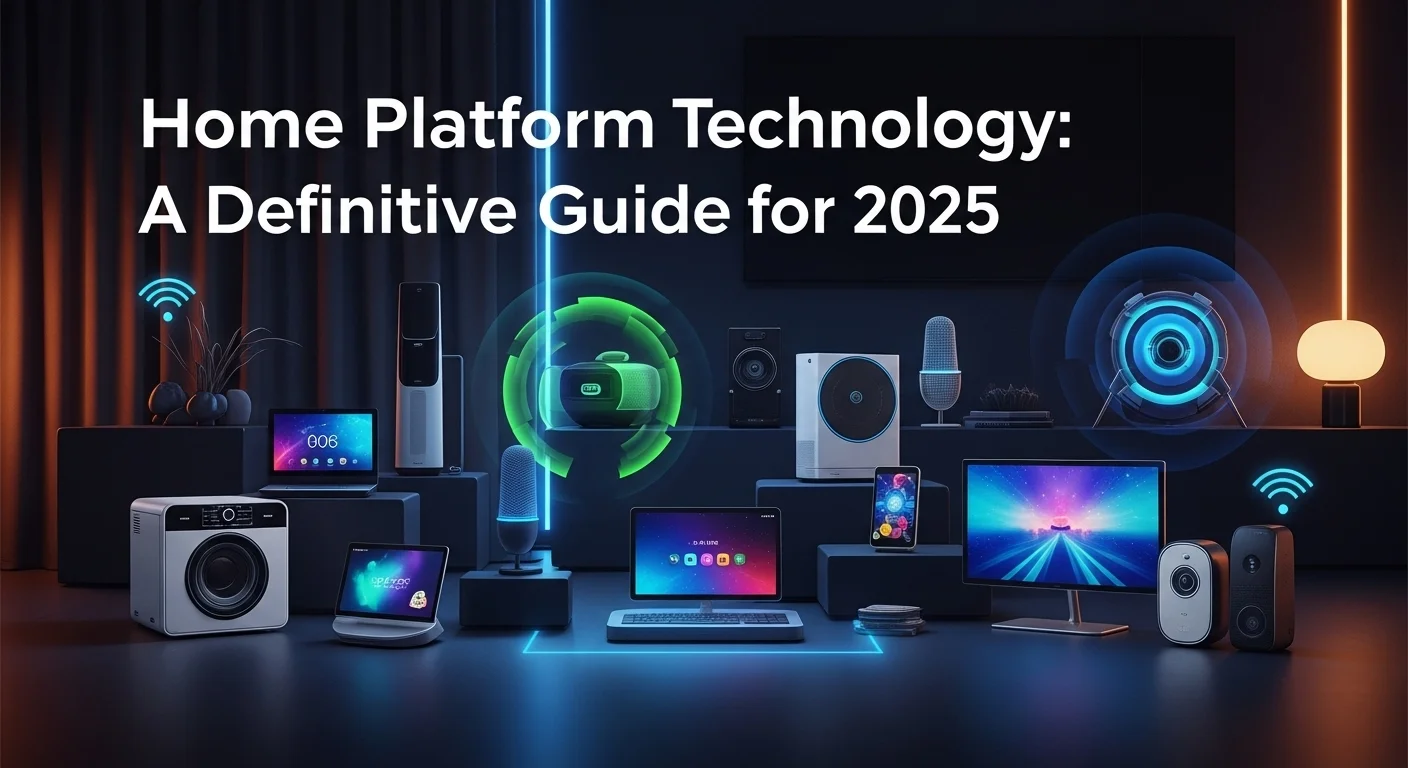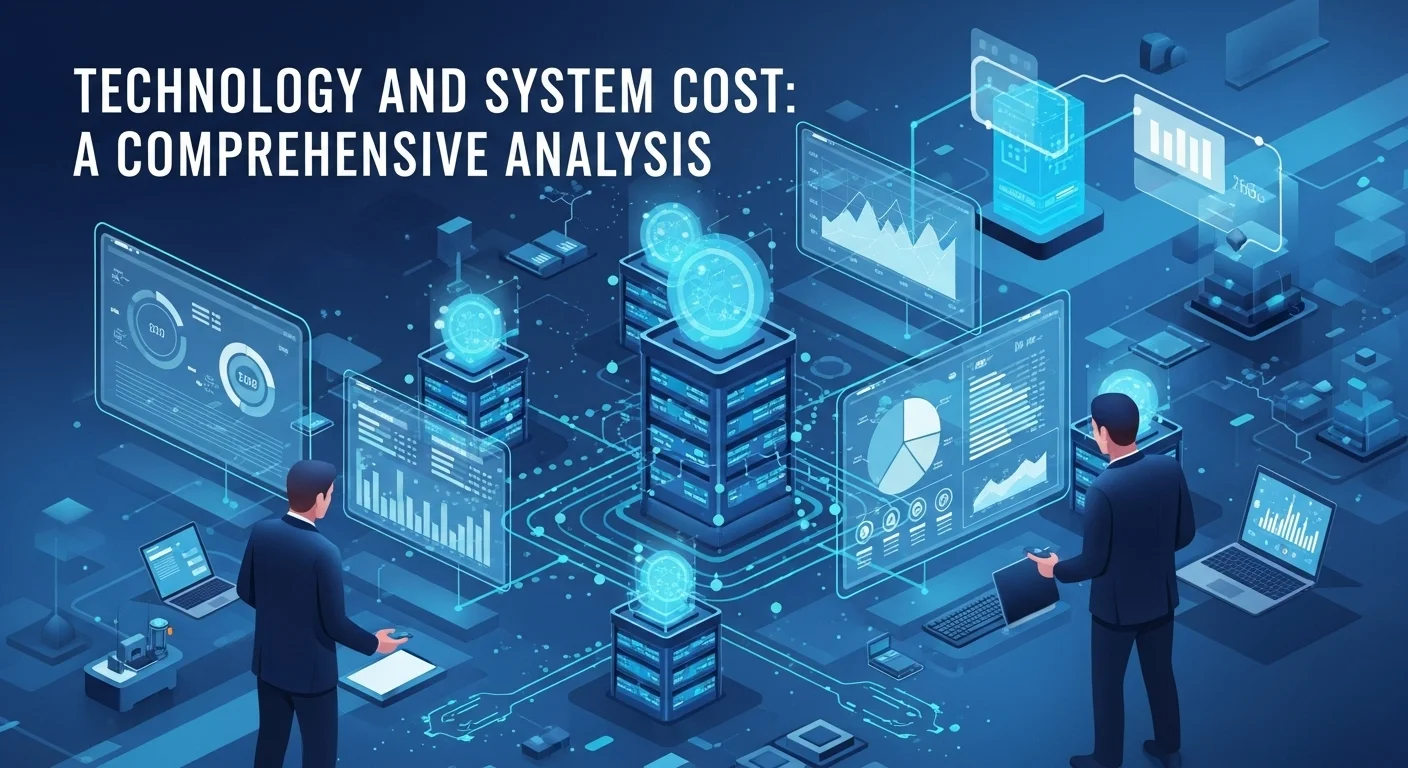What is a Home Platform? My 2025 Guide to Smart Home Tech

Executive Summary
I remember the early days of 'smart homes'—a messy collection of clunky apps and gadgets that just wouldn't talk to each other. It was frustrating. Today, things are worlds apart. A good home platform acts as the central brain, the conductor of an orchestra, bringing everything together from your lights and locks to entire business operations. This isn't just about yelling at a speaker to play a song anymore; it's about creating genuinely intelligent, responsive spaces. In this guide, I'll draw on my years of experience to walk you through what these platforms really are, why they're so important for both homeowners and businesses, and how to pick the right one as we look toward 2025.
Table of Contents
What is a Home Platform and Why Does It Matter?
For years, I've watched the term 'Home Platform' evolve from niche tech jargon to the very heart of the modern digital home. So what is it? Simply put, a smart home platform is the command center that allows all your different smart devices to speak the same language. Think of it as the digital glue for your smart lights, thermostat, security cameras, locks, and speakers. It lets them work together in harmony, all managed from one place, like an app on your phone or through a voice assistant. This technology goes way beyond just turning a single light on or off. It’s about creating an intelligent environment where devices react to each other, learn your habits, and automate routines to make your life easier. Its importance is huge. As the Internet of Things (IoT) explodes with billions of connected devices, we desperately need a way to manage the chaos. Without a solid platform, a 'smart home' is just a box of disconnected gadgets. The platform provides the structure, turning that chaos into a streamlined, responsive, and truly smart ecosystem.
The Technology Inside a Home Platform
To really get why this matters, it helps to peek under the hood. A platform is built in layers. First, there's the hardware, which might be a dedicated box called a hub or gateway. I've set up dozens of these. They use wireless signals like Zigbee or Z-Wave to talk to devices, which is great because it doesn't clog up your main Wi-Fi. The next layer is the software—the brains of the operation. This software lives on the hub and in the cloud, processing your commands and running automations. The cloud part is key for letting you check on your home from your office or on vacation, and it's where a lot of the powerful AI magic happens. The final layer is what you see and touch: the app on your phone or the voice of your smart speaker. When I work with the Google smart home platform, for instance, it's all about the seamless experience between talking to the Google Assistant and using the Google Home app. When people ask me for the best smart home platform, I tell them it's often about how well these layers work together. Looking ahead, the whole industry is buzzing about what the best smart home platform for 2025 will be, especially with the new Matter standard. Matter promises to let devices from different brands finally work together effortlessly, shifting the focus from 'what works with what' to the quality of the software and user experience itself.
Business Applications and Commercial Importance
While most of us first encountered this tech in our homes, its impact on the business world is staggering. A well-implemented platform is an incredible tool for so many industries. In real estate, I've seen property managers use a central system to handle keyless entry for hundreds of apartments, get alerts for water leaks, and offer a 'smart apartment' package that tenants love. It's a game-changer for both efficiency and property value. In hospitality, hotels use these systems to let guests control their entire room—lights, temperature, TV—from their own phone, creating a really slick, modern experience. For businesses watching their bottom line, a smart platform can optimize energy use by automatically adjusting lights and air conditioning based on whether people are in the building, saving a ton of money. I've also consulted on projects in assisted living, where these platforms create safer environments for seniors with medication reminders, fall detection, and simple ways to call for help. For developers like me, this creates a huge opportunity. We can build specialized devices that plug into big ecosystems like Google's, or help businesses design custom solutions from the ground up. Even the DIY community, often using the best home assistant platform, Home Assistant, has created an entire market around custom, privacy-focused smart systems.
The Real-World Benefits of a Centralized Platform
Adopting a central platform isn't just a tech upgrade; it brings real, tangible benefits that I've seen firsthand change how people live and work.
- Next-Level Convenience and Automation: This is the wow factor. Instead of fumbling with ten different apps, you have one. But the real magic is automation. I set up a 'Good Morning' routine for a client that slowly fades up the lights, warms the house, starts the coffee, and plays the news, all triggered by their morning alarm. It’s a small thing that makes a big difference.
- Serious Energy Efficiency: Smart thermostats and lights, when working together, are brilliant at saving energy. The system learns your schedule and can turn off lights in empty rooms or adjust the AC when you're gone. For a business, these savings go straight to the bottom line and help with green initiatives.
- A Real Sense of Security and Safety: A modern platform ties your cameras, sensors, and locks into one cohesive security system. You get instant alerts if a door opens when it shouldn't, and you can let a delivery person in remotely after checking the video doorbell. I always recommend setting up a 'Vacation' mode that randomly turns lights on and off to make it look like someone's home.
- Personalized Insights from Data: Over time, the platform learns about your home. It can show you which appliances are energy hogs or help you optimize your daily routines. The best platforms use this data to get smarter, almost anticipating what you need before you do. The race to be the best smart home platform is really a race to be the most intelligent and helpful.
- Future-Proof and Ready to Grow: Choosing a good platform means your system can evolve. You can start small with a few bulbs and add more devices over time without hitting a wall. With the Matter standard on the horizon, the best smart home platform for 2025 will be the one that gives you the most flexibility, ensuring your investment today is still smart tomorrow.
At the end of the day, a Home Platform brings order and intelligence to our increasingly connected world. It's about creating environments that are not just full of gadgets, but are genuinely smart, responsive, and valuable.

A Complete Guide to Home Platforms for Tech and Business
Diving into the world of home platform technology can feel overwhelming. I get it. To really make sense of it, you have to look at the tech that makes it tick, the strategies businesses are using, and the main players in the game. This guide is my attempt to cut through the noise for everyone from business leaders to tech enthusiasts. We’ll look at the protocols, compare the big names from my hands-on experience, and get you ready for what to expect from the best smart home platform in 2025.
Tech Talk: Communication and Making It All Work Together
The secret sauce of any smart environment is how the devices talk to each other. This happens over different wireless protocols, and each has its place.
- Wi-Fi: It's everywhere, and it's fast, making it perfect for things like security cameras that send a lot of data. The downside? It can be a power hog for battery devices, and I've seen home networks grind to a halt when too many gadgets are connected.
- Bluetooth / BLE: Great for short-range connections, like your phone unlocking your front door. Bluetooth Low Energy (BLE) is its super-efficient cousin, ideal for small battery-powered sensors that just need to send tiny bits of information.
- Zigbee: This is a workhorse for home automation. Its superpower is creating a 'mesh network.' Every plugged-in device, like a smart plug, acts as a signal booster, making the network stronger and more reliable as you add more things. It’s a very robust system.
- Z-Wave: Similar to Zigbee, Z-Wave also creates a mesh network. Its main advantage in my experience is that it uses a different radio frequency, so it's less likely to get interference from your Wi-Fi. The devices are often a bit pricier but tend to be very reliable.
- Thread and Matter: The Future is Here. This is the development I'm most excited about. Thread is a modern mesh network protocol, but Matter is the real star. It’s a universal language that runs on top of Thread and Wi-Fi. Backed by giants like Google, Apple, and Amazon, Matter is designed to make all certified smart devices work with all major platforms. When a client asks me about future-proofing, my answer is always 'Look for Matter support.' It will radically simplify everything.
A hub or controller often acts as the translator between all these languages and connects your local network to the internet. We're seeing more and more of this functionality built right into devices like Google's Nest Hubs, which simplifies setup a lot.
The Big Four and a Wild Card: A Platform Comparison
Choosing a platform is a big deal. Here's my take on the major players after years of working with all of them.
1. Google Home / Google Assistant
The strength of the Google smart home platform is its intelligence. Google Assistant is fantastic at understanding natural language.
Pros: The voice assistant feels the most like a conversation. Its routines are powerful, and it integrates beautifully if you're already in the Google/Android world. They are all-in on Matter.
Cons: For some, the Google Home app can feel less intuitive for managing a ton of devices, though it's improving. Data privacy is a valid question for some users.
My Take:: Best for those who live in the Google ecosystem and want the smartest voice assistant on the market.
2. Amazon Alexa
Alexa brought smart speakers to the masses. Its advantage is its sheer size and dominance.
Pros: The number of 'Works with Alexa' devices is massive. You can find a gadget for almost anything. The third-party 'Skills' library is also huge. Plus, many Echo devices have a Zigbee hub built-in, which is a great value.
Cons: I find Alexa to be less capable with complex or conversational questions compared to Google. The app can feel cluttered.
My Take: Go with Alexa if you want the absolute widest selection of compatible gadgets and love trying out new integrations.
3. Apple HomeKit
HomeKit is classic Apple: secure, private, and polished.
Pros: Its focus on privacy is unmatched. Processing happens locally on your Apple TV or HomePod whenever possible. The Home app is clean, simple, and beautifully integrated into all Apple devices.
Cons: The device selection is much smaller and generally more expensive. It's a walled garden; you have to be an Apple user.
My Take: The only choice for privacy-focused users who are all-in on Apple and value a seamless, 'it just works' experience.
4. Samsung SmartThings
SmartThings has always been for the power user. It’s incredibly flexible and supports a huge range of devices.
Pros: It's a beast for creating complex automations that can run locally, even without an internet connection. It supports Zigbee, Z-Wave, and now Matter.
Cons: It can have a steeper learning curve. The transition to their new platform a while back was a bit bumpy for long-time users like myself.
My Take: Perfect for tinkerers who want to mix and match protocols and build highly sophisticated automations.
5. Home Assistant
For those who want total control, Home Assistant is in a league of its own. It's the ultimate DIY platform.
Pros: It’s free, open-source, and runs on your own hardware (like a simple Raspberry Pi). Your data never leaves your house, offering ultimate privacy. The customization is limitless.
Cons: This is not plug-and-play. It requires a good amount of technical skill and time to set up and maintain. You are your own support team.
My Take: This is the best home assistant platform for enthusiasts, developers, and privacy purists who enjoy getting their hands dirty and want to build a system that is 100% theirs.
Business Strategies and Available Resources
For businesses, using these platforms isn't just about cool tech; it's a strategic move.
- Property Tech (PropTech): I've worked with developers who use platforms like SmartThings to offer a 'Smart Home as a Service' package in new buildings. This becomes a major selling point.
- Insurance & Risk: Insurance companies are offering discounts for installing smart smoke and water leak detectors. They use the (permissioned) data to reduce their risk, creating a win-win.
- Senior Care: Healthcare companies are using these platforms to build solutions for seniors living independently, with automated reminders, fall detection, and easy communication with family.
- Energy Consulting: Using a powerful platform like Home Assistant, consultants can perform detailed energy audits for clients and set up automations that deliver clear, measurable savings.
For any business planning for the future, the key is flexibility. The best smart home platform for 2025 will be one that fully embraces open standards like Matter, freeing businesses from being locked into one brand and opening up a world of possibilities.

Tips & Strategies to Get the Most from Your Home Platform
So, you've started building your smart home. The real magic isn't just in connecting devices; it's in making them work for you in a smart, secure, and reliable way. Over the years, I've developed a list of best practices that I share with every client, whether they're a homeowner or a business. These are the tips that separate a frustrating pile of gadgets from a genuinely helpful smart environment.
Best Practices for a Rock-Solid and Secure Smart Home
Let's start with the most important thing. I can't stress this enough: security is job number one. A weak link can expose your privacy and even your physical safety. Here’s my non-negotiable checklist:
- Lock Down Your Wi-Fi: Your router is the front door to your digital world. Use a strong, unique password (not the one on the sticker!). If your router supports WPA3 encryption, use it. And please, change the router's admin login from 'admin' and 'password'!
- Create a Guest Network for IoT Devices: This is a pro tip that makes a huge difference. Most modern routers let you create a separate guest network. I always put all smart home devices—lights, plugs, sensors—on this network. This isolates them from your main network where your computers and personal files live. If a cheap smart plug ever gets hacked, the damage is contained.
- Use a Password Manager: Every device and app account needs its own strong, unique password. A password manager is the only sane way to handle this. And turn on two-factor authentication (2FA) for your main platform accounts (like your Google or Amazon account). It's a lifesaver.
- Keep Everything Updated: I know update notifications are annoying, but they are critical. Manufacturers release updates to patch security holes. Set your devices, hubs, and apps to update automatically whenever possible. An outdated system is an insecure system.
- Read the Fine Print (Permissions): When you add a new device or service, pay attention to what it's asking for. Does that simple light bulb app really need access to your contacts? Be skeptical.
- Stick with Reputable Brands: Those super-cheap, no-name devices can be tempting, but I've seen them come with major security flaws or get abandoned by the manufacturer, leaving them vulnerable forever. It's worth paying a bit more for a brand with a good reputation.
- For Ultimate Privacy, Go Local: If you're deeply concerned about your data, the best path is a platform that runs locally in your home, like Home Assistant. With this setup, your data doesn't need to touch a third-party cloud server. It’s more work, but it gives you complete control.
Crafting Automations That Are Actually Smart
This is the fun part. Let’s move beyond remote control and make your home anticipate your needs.
- Start with 'Scenes': Before building complex rules, create simple scenes. My 'Movie Night' scene dims the living room lights, turns on the TV, and sets the soundbar to the right input with one command.
- Think in Layers: Trigger -> Condition -> Action: The best automations follow this logic. The Trigger is the 'if' (e.g., motion is detected). The Condition is the 'only if' (e.g., it's after sunset AND I'm not home). The Action is the 'then' (e.g., turn on the porch light AND send me an alert).
- Use Your Phone for Presence Detection: Geofencing is one of the most powerful tools. Set up 'Home' and 'Away' modes that trigger automatically when the last person's phone leaves the house or the first person's phone arrives. This is fantastic for saving energy and ensuring security.
- Let Sensors Be Your Senses: Motion sensors are just the beginning. I love using contact sensors on doors to trigger hallway lights. A water leak sensor under the sink can save you from a disaster by sending an alert to your phone.
- Create Circadian Lighting: This is a wellness-focused automation I love. Program your lights to have a cool, energetic blue-white tone in the morning and automatically shift to a warm, relaxing orange glow in the evening. It really helps align with your body's natural rhythm.
Business Tools and Real-World Experience
For businesses, these platforms are strategic assets. The key is to leverage their deeper capabilities.
- APIs are Your Best Friend: The Application Programming Interface (API) is how you connect the smart platform to other business software. For example, using the Google smart home platform API, a hotel can integrate room controls directly into their guest booking system.
- Unlock Insights with Data: The data from smart devices is incredibly valuable. A property manager can analyze energy data across all their units to spot faulty HVAC systems before they fail, saving thousands in emergency repair costs.
- Find Vertical Solutions: Look for companies that specialize in your industry. In hospitality, for instance, there are turnkey solutions that package room controls, entertainment, and guest services, all built on a major smart home ecosystem.
- A Crucial Resource I Always Recommend: If you're serious about this space, you need to understand Matter. The best place for information is the official website of the Connectivity Standards Alliance (CSA), the organization behind the protocol. I send all my clients to csa-iot.org/all-solutions/matter/. It has the latest news and lists of certified products. Understanding Matter is fundamental to making a smart investment for 2025 and beyond.
By pairing strong security with thoughtful automation and leveraging the right tools, you can transform your home or business from just being 'connected' to being truly intelligent, secure, and valuable.
Expert Reviews & Testimonials
Sarah Johnson, Business Owner ⭐⭐⭐
A solid overview of Home Platforms. I would have loved to see a few more real-world case studies for small business owners like myself.
Mike Chen, IT Consultant ⭐⭐⭐⭐
This was a really helpful read on Home Platforms. It clarified the different protocols for me, though some of the deeper tech concepts could be broken down even more.
Emma Davis, Tech Expert ⭐⭐⭐⭐⭐
Fantastic article! A truly comprehensive guide to Home Platforms. This was perfect for my specialization work, and I understood everything clearly. Great job!



